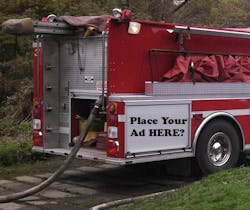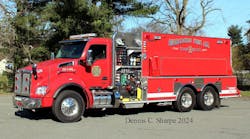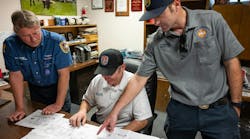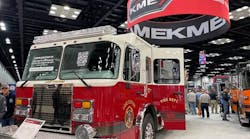Bravo to the firefighters of Middle River, Md., Volunteer Fire Company. I read with interest about their story about sale of ad space on their ladder and engine.
It’s difficult enough to be a volunteer firefighter these days, with the pressures of training and family, and work and community service and… and. The list is endless. Raising money for an activity you do as a volunteer is a sign of true dedication and love of the fire service. So, coming up with a way to make a few bucks without a lot of work has got to be a good idea.
I know my position is not without its detractors and naysayers, but you’ve got to admit it doesn’t take much effort to slap an ad on an apparatus and let it passively make money for your department.
Do I want to see apparatus looking like a NASCAR racer? Not really. But I see no harm in putting some discrete ads on fire apparatus. Are there some that are not appropriate? Absolutely. But in Middle River’s case, the ad space happened to be for a local heating, cooling and plumbing company with ties to the department.
Those who have trouble with the business model are not facing reality. Volunteers are dropping in alarming numbers because of all the internal and external pressures. At the same time, funding is dropping from both municipal sources and donations. People just don’t have the funds to give as liberally as they might like to or may have had in the past.
Public radio and television has long used the model of listener and viewer contributions combined with small amounts of tax dollars. We’ve all heard the National Public Radio “ads.” They almost always “sneak” them in using the same radio personalities that do the announcing. They don’t take away from the programming, but they do allow us to enjoy what otherwise might not be possible. The key to making it work is subtlety and discretion.
As Middle River’s Lt. Bill Connelly says, those who are against the concept are traditionalists. What’s that saying now…. Oh yeah. “More than 200 years of tradition unencumbered by progress.” That axiom is almost definitely in play with opponents of ads on apparatus.
Remember back in 2010, KFC, the Kentucky-based fried chicken company, offered money to cities that let them advertise fiery chicken wings on fire hydrants? Brazil, Ind., is one of the cities that took the offer and got a reported $7,500 for hydrant repairs in the community some 60 miles outside of Indianapolis. In exchange, KFC got to “decorate” the hydrants with simulated buckets of chicken and cardboard wrappings around the base. They didn’t appear to hinder fire operations in anyway and if they last more than a few weeks, it would be a surprise.
At the time of the exchange, Brazil’s mayor, Ann Bradshaw issued a news release saying the city had deferred hydrant maintenance for years because of the lack of funding. She continued and stated: “We’re thrilled that KFC recognizes that cities are being force to make these difficult decisions and has stepped up to help us.”
That’s the right answer and kudos to Mayor Bradshaw. People for Ethical Treatment of Animals (PETA) had a different reaction about the ads for different reasons – they objected to the businesses practices of KFC. Ironically, they proposed the now infamous PETA ad plastered on the back body of a fire apparatus. They too saw the value of getting their message out on a big red truck.
There’s been some discussion about Middle River being the first in the nation to sell advertising on their apparatus. A bit of research shows that Stockton, Calif. firefighters allowed a local food coop to place an ad on their new engine back in 2009.
The “Food 4 Less” company gave the city $200,000 to “sponsor” a city engine. The city was given a $400,000 federal grant for the rig, but it wasn’t enough to cover the purchase cost and to equip it. The concept seemed to work although there were some that squawked about it. Nevertheless, the city got a new apparatus and didn’t have to raise taxes to do it.
Some may say communities just ought to bite the big bullet and cover the cost of apparatus, period. If this was paradise, that might be case. But not every community can pull that off. When community leaders are facing employee layoffs, years of infrastructure repair deferrals and tattered textbooks in the classrooms, they might welcome a lifeline of a few dollars coming in from the private sector that’s not squeezed from taxpayers.
For decades, mass transit has been a venue for advertising and it’s helped underwrite buses, subways, light rail and everything connect with public transportation. Why is it such a leap to include fire apparatus in that line up?
I do understand there might be issues about who is allowed to advertise. We might not want the local adult book store adorning our fire trucks with “hot and steamy” whatever. So, we’d have to develop regulations that govern content, size, colors and enforce them. Easier to say than to get done, but I am sure if there’s a will there’s a way. After all, we have to remember the mission of fire apparatus is safety and public service and balance that with the advertisers’ needs.
Without a doubt, ads on fire trucks is, and will be a controversial topic for years to come. There’s no right, or wrong, answer on this one and it will boil down to what your community will tolerate and how “desperate” the department is for funding.
In an ideal world, we wouldn’t even be talking about this concept. But it’s not ideal and this is just one way to make it a little easier to endure.
What do you think? I’d love to hear your thoughts.






